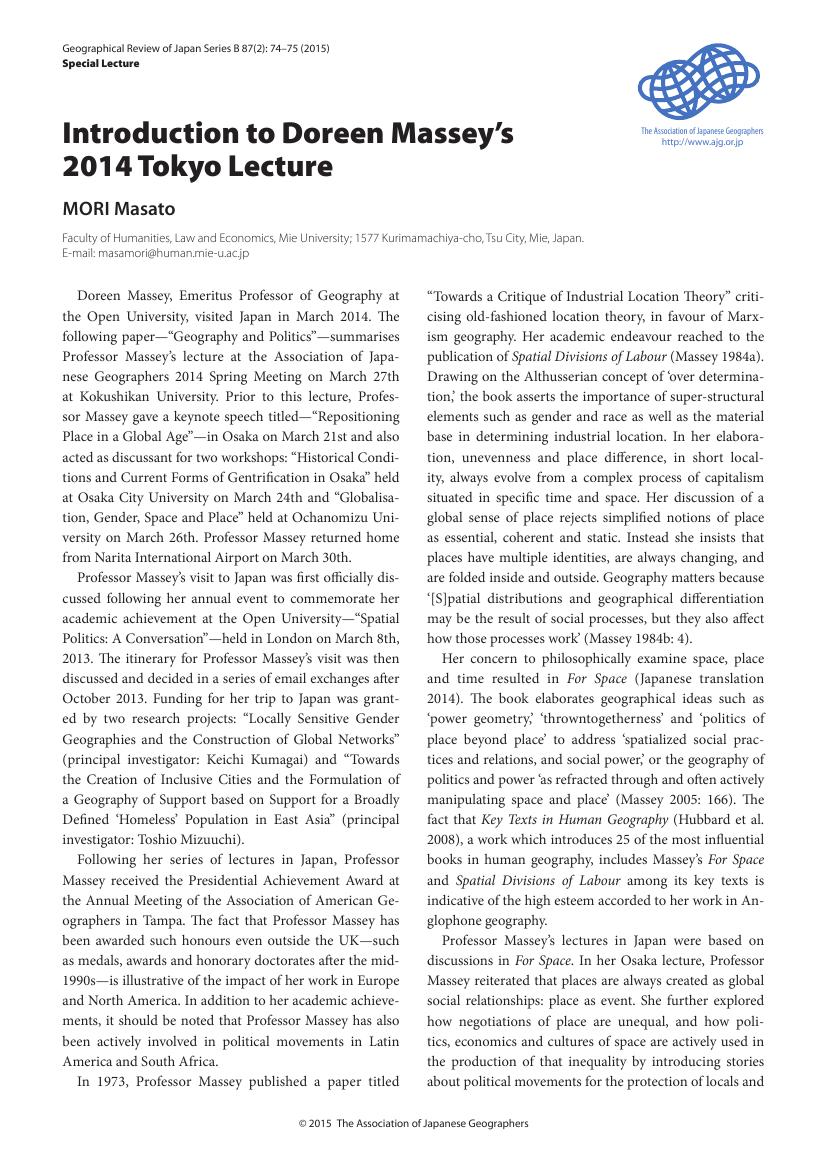49 0 0 0 IR 1930年代に発見される楠木的なるもの
- 著者
- 森 正人 Mori Masato
- 出版者
- 三重大学人文学部文化学科
- 雑誌
- 人文論叢 (ISSN:02897253)
- 巻号頁・発行日
- no.26, pp.147-159, 2009
本稿は1934年の建武中興六百年祭と35年の大楠公六百年祭が、資本や寺院や地方自治体の関わりによってどのように演出されたのか考える。そしてそれを契機にして楠木正成に関わる事物や景観や人物などがどのように価値付けられたり発見されたりしたのかも紹介する。そうした過程は地域という地理的単位と結びついて展開した。それゆえ、地域なるものと国家なるものが関係的に立ち現れることが最後に示される。
43 0 0 0 IR 近代国民国家のイデオロギー装置と国民的偉人--楠木正成をめぐる明治期のふたつの出来事
- 著者
- 森 正人 Mori Masato
- 出版者
- 三重大学人文学部文化学科
- 雑誌
- 人文論叢 (ISSN:02897253)
- 巻号頁・発行日
- no.24, pp.165-177[含 英語文要旨], 2007
36 0 0 0 IR 1935年の楠木正成をめぐるいくつかの出来事--ナショナル・ローカル・資本
- 著者
- 森 正人 Mori Masato
- 出版者
- 三重大学人文学部文化学科
- 雑誌
- 人文論叢 (ISSN:02897253)
- 巻号頁・発行日
- no.25, pp.115-128, 2008
3 0 0 0 OA 近代国民国家のイデオロギー装置と国民的偉人 : 楠木正成をめぐる明治期のふたつの出来事
- 著者
- 森 正人 Mori Masato
- 出版者
- 三重大学人文学部文化学科
- 雑誌
- 人文論叢 : 三重大学人文学部文化学科研究紀要 (ISSN:02897253)
- 巻号頁・発行日
- vol.24, pp.163-177, 2007-03-30
3 0 0 0 OA 1935年の楠木正成をめぐるいくつかの出来事 : ナショナル・ローカル・資本
- 著者
- 森 正人 Mori Masato
- 出版者
- 三重大学人文学部文化学科
- 雑誌
- 人文論叢 : 三重大学人文学部文化学科研究紀要 (ISSN:02897253)
- 巻号頁・発行日
- vol.25, pp.115-128, 2008-03-01
2 0 0 0 OA 「空前絶後!」四国八十八ヶ所霊場出開帳 : スペクタクルとしての巡礼と巡礼空間の生産
- 著者
- 森 正人 モリ マサト MORI Masato
- 出版者
- 三重大学人文学部文化学科
- 雑誌
- 人文論叢 : 三重大学人文学部文化学科研究紀要 (ISSN:02897253)
- 巻号頁・発行日
- vol.22, pp.A65-A80, 2005-03-31
本稿は一九三七年に大阪で南海電鉄会社が行った「四国八十八ヶ所霊場出開帳」に注目し、それがどのような社会的過程で生産されたのかを詳述する。これまでの四国遍路史上、たった一度だけ成功を収めたのが一九三七年の出開帳である。この出開帳は宗数団体が主催したものでも四国内で行われたわけでもなかったため、従来の研究ではほとんど取り上げられることはなかった。またこれは、鉄道・出版資本、国家政策、仏教寺院がそれぞれの思惑を交差させながら重層的に生産されたのである。したがって、この出開帳を取り上げることにより、四国遍路自体の複雑性を示すことができる。また従来の研究における静的な巡礼空間モデルに対して、巡礼空間が社会的構築物であること、さらに、生産された空間が社会的構成を行う社会-空間弁証法が見られることを示すこともできると考える。
1 0 0 0 OA 1930年代に発見される楠木的なるもの
- 著者
- 森 正人 Mori Masato
- 出版者
- 三重大学人文学部文化学科
- 雑誌
- 人文論叢 : 三重大学人文学部文化学科研究紀要 (ISSN:02897253)
- 巻号頁・発行日
- vol.26, pp.147-159, 2009-03-31
本稿は1934年の建武中興六百年祭と35年の大楠公六百年祭が、資本や寺院や地方自治体の関わりによってどのように演出されたのか考える。そしてそれを契機にして楠木正成に関わる事物や景観や人物などがどのように価値付けられたり発見されたりしたのかも紹介する。そうした過程は地域という地理的単位と結びついて展開した。それゆえ、地域なるものと国家なるものが関係的に立ち現れることが最後に示される。
- 著者
- MORI Masato
- 出版者
- The Association of Japanese Geographers
- 雑誌
- Geographical review of Japan series B (ISSN:18834396)
- 巻号頁・発行日
- vol.87, no.2, pp.74-75, 2015 (Released:2015-07-04)
- 参考文献数
- 4
1 0 0 0 IR 言葉と物--英語圏人文地理学における文化論的転回以後の展開
- 著者
- 森 正人 Mori Masato
- 出版者
- 人文地理学会
- 雑誌
- 人文地理 (ISSN:00187216)
- 巻号頁・発行日
- vol.61, no.1, pp.1-22[含 英語文要旨], 2009
This article traces some trajectories of social and cultural geography since the end of the 1980s to the early 2000s and attempts to explain how the geography of materiality has become a matter in current Anglophone geography, especially in the United Kingdom. Although the new cultural geography of Japan redefines social and cultural geography and focuses on discursive practices and representations, in Japan there is low awareness of discussions on post-humanism, which is a topic in Anglophone geography. Anglophone geography consists of topics such as materiality, performativity, complexity theory, and actor-network theory. There is no paper in the Japanese or English literature in Japan that discusses such topics. Hence, this article attempts to establish a framework to facilitate the discussion of topics such as those mentioned above. To begin with, the process of development of the new cultural geography is detailed in order to review the questions raised towards the end of the 1980s on both sides of the Atlantic. The new social and cultural geography has progressed beyond the conventional understanding of culture, which is sustained by traditional cultural geography, stressing the complex relation between culture, economy and politics, and has also served to underline the crisis in geographical representations associated with anthropological discussions. In this consideration, moral geography, which forms webs of ideologies through space, place, and landscape, is examined. There have been criticisms of the new cultural geography, of which a problem of reification of the idea of culture is noted here. However, the controversy around this criticism seemingly still retains a problem of metaphysics, and rigidly assumes the existence of 'subject' and 'object'. Phil Crang's paper that intends to combine the cultural aspect with economic geography implies the idea of culture and economy as something performed. It states that there is no linearity or predetermined harmony among cultural, economic and political practices. This point of view was amplified in some lines of discussions in the late 1990s. Second, theoretical frameworks for performativity, hybridity, ethics, non-representational theory, complexity theory, and actor-network theory are outlined in this essay. The power of things, women, nature, etc. that have been objectified is included as these discussions revolve around the issue of western metaphysics which continually attempts to establish a rigid division between the subject and the object. The distinction has been always/already mediated by the corporeal. The traces left by the corporeal or things reveals the impossibility of the execution of the project of western metaphysics. Ethics are centered, instead of moral geography, to grasp the entanglement of humans and non-humans. Third, criticism of the material turn that occurred at the end of the 1990s is studied. The discussion on materiality became a critical vehicle to overcome the weakness of verbal analysis. Mike Crang's papers on heritage show that materiality emerges in various practices and affects people's memories. Materiality is not only an issue of matter. Subsequently, there is reference to a controversy between Daniel Miller, who influenced the material turn in geography, and Michel Callon, who proposed the actor-network theory. It demonstrates how Miller is captured by the classic Hegelian/Marxist concept: Miller assumes the linearity of ideology in a market and the predominance of the subject over the object. It is, therefore understandable that some geographers were accused of continuing to retain Hegelian beliefs, i.e., the belief that there is a binary relation between subject/object, spirit/thing, and human/nature. Finally, the concept of post-humanism that summarizes the bundle of discussions mentioned before, and an ontological understanding of existence (e.g., in geography, space, place, landscape, etc.) are explained. An understanding these topics leads to a grasp of current topics such as affect, complexity, a 'more-than-human world', liquidity, and care.
1 0 0 0 OA 節合される日本文化と弘法大師 : 1934年の「弘法大師文化展覧会」を中心に
- 著者
- 森 正人 Mori Masato
- 出版者
- 日本地理学会
- 雑誌
- 地理学評論 = Geographical review of Japan (ISSN:18834388)
- 巻号頁・発行日
- vol.78, no.1, pp.1-27, 2005-01-01
本稿は,「節合」という概念を手掛かりとして,1934年の弘法大師1100年御遠忌で開催された「弘法大師文化展覧会」を中心として,弘法大師が日本文化と節合され,展示を通して人々に広められる過程を追う.この展覧会は,戦時体制に協力する大阪朝日新聞と御遠忌を迎えた真言宗による「弘法大師文化宣揚会」が開催したものであった.この展示には天皇制イデオロギーを表象する国宝や重要文化財が,弘法大師にも関係するとして展示された.また展示会場は近畿圏の会館や百貨店であり,特に百貨店では都市に居住する広い階層の人々に対して,わかりやすい展示が試みられた.このような種別的な場所での諸実践を通して国民国家の維持が図られた.ただし会場を訪れた人々は,イデオロギーの中に完全に取り込まれてしまうのではなく,それを「見物」したり,娯楽としてみなしたりする可能性も胚胎していた.
